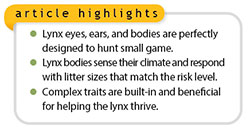 Not all tour guides in Alaska are human. Amazing animals of Alaska can guide us into learning creation truth. In fact, such animals should direct us—like projected arrows1—toward understanding the greatness of our Creator. This guidance is illustrated in Alaska’s land creatures, birds of the air, and beasts of its coastal seawaters.2
Not all tour guides in Alaska are human. Amazing animals of Alaska can guide us into learning creation truth. In fact, such animals should direct us—like projected arrows1—toward understanding the greatness of our Creator. This guidance is illustrated in Alaska’s land creatures, birds of the air, and beasts of its coastal seawaters.2
“But now ask the beasts, and they will teach [literally guide or direct] you; and the birds of the air, and they will tell you;…and the fish of the sea will explain to you…that the hand of the LORD has done this.” (Job 12:7-9)
Alaska’s lynx (Lynx canadensis) lives throughout most of Alaska, especially in its boreal forests. Its favorite fare is snowshoe hare (Lepus americanus). About every 10 years, this rabbit-like hare’s population explodes—and the lynx population surges soon after. If the lynx population didn’t respond in this manner, hungry hares would strip forests and brush of young vegetation, starving out other herbivores.3,4
But hares quickly flee danger, so how can lynxes locate and leap upon lagomorph lunches? The answer is found in the anatomy of the lynx. Christ the Creator caringly endowed the lynx with physical traits to match the lynx’s post-Fall diet of hares, squirrels, voles, and birds.4
Lynx ears, like those of their bobcat cousins, hear fainter and higher-pitched frequency sounds than we do. Tufts atop lynx ears act as antennas, providing precision when matching sounds to their locations. Lynx night vision—also used during twilight—is sixfold superior to ours, with better peripheral vision, noticing even the slightest movements in brush or snow.3
Lynxes are designed to spring and pounce—their spinal vertebrae are “held together largely by muscles rather than ligaments,…[so the lynx] backbone is extremely flexible and can lengthen, contract, and even twist” while sprinting or leaping.3 Lynx hind legs spring quickly, adding an early advantage to a chase. Its paw pads are huge and broad like snowshoes, just right for chasing small game without sinking into snowdrifts. Lynx claws are retractable, so claw sharpness isn’t dulled when walking or running. Its long canine teeth puncture well; like garden shears, its carnassial teeth cut and snip the flesh of its prey.3
Not only are lynx fitted to fill their habitats, they are designed to be fruitful and multiply. Their reproductive system adjusts for habitat conditions.4 Lynx mothers in the colder northern ranges average three kittens per litter. This links latitudinal weather extremes (that limit available prey and thus increase starvation risk) with reproductive success (for procreative replacement of parental generations).
However, in milder southern ranges the lynx mothers average two kittens per litter. Due to climate-related food scarcity challenges, in northern ranges survivability is riskier for both newborn lynx kittens and for their mothers because lactation is bioenergetically demanding—i.e., providing hungry kittens with milk is a recurring activity that’s metabolically expensive for nursing mothers.3,4
Thus, God’s providence in ecology comes to bear with splendid craftsmanship. It makes sense that lynx mothers use built-in phenological sensors that provide continuous environmental tracking of daylight hours (per 24-hour cycle) to recognize the latitude of their respective range. The lynx mother’s internal response to that tracked geographical data influences her fertility and litter size to match the relative survivability risks linked to latitude challenges.
Surely this fleet-footed feline is intentionally designed for a cool, carnivorous lifestyle. Thanks to the creative providence of the Lord Jesus Christ, Alaska’s lynx is fitted to fill its habitats on the earth.
References
- The Hebrew verb translated “teach” in Job 12:7 is also translated “cast” (Genesis 31:51; Proverbs 26:18), “shoot [arrows]” (1 Samuel 20:20, 36-37; Psalm 11:2; 2 Kings 13:17; 2 Chronicles 35:23), and “direct” (Genesis 46:28), with the common concept being aim, direction, or guidance toward an archer’s target or goal-like destination.
- Due to space limitations only one land mammal example is given here. Regarding humpback whales, one of Alaska’s marine mammals, see Guliuzza, R. J. Whale Fin Inspires Safer Racing Wheels. Creation Science Update. Posted on ICR.org January 11, 2018, accessed March 11, 2021. Exemplifying Alaska’s birds, see Johnson, J. J. S. Alaskan Alcids: Efficiently Designed for Air and Water. Creation Science Update. Posted on ICR.org July 20, 2020, accessed March 11, 2021.
- Kobalenko, J. 2005. Forest Cats of North America: Cougars, Bobcats, Lynx. Buffalo, NY: Firefly Books, 46-47.
- Koehler, G. M. and K. B. Aubry. Lynx. In The Scientific Basis for Conserving Forest Carnivores: American Marten, Fisher, Lynx, and Wolverine in the Western United States. Ruggerio, L. F. et al, eds. Fort Collins, CO: USDA Forest Service, 74-98.
* Dr. Johnson is Associate Professor of Apologetics and Chief Academic Officer at the Institute for Creation Research.




